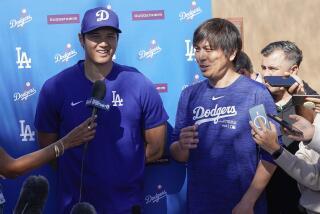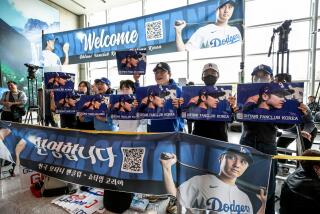Author profile: Manga artist Takehiko Inoue has hoop dreams
Readers over 30 may not recognize manga artist Takehiko Inoue’s name, but teens and twentysomethings in America, Japan, France, Brazil and 19 other countries follow the misadventures of basketball star wanna-be Hanamichi Sakuragi in “Slam Dunk,” samurai Miyamoto Musashi’s progress on the musha shugyo (“warrior’s path”) in “Vagabond” and the struggles of wheelchair basketball ace Kiyoharu Togawa in “Real.” Inoue has sold more than 157 million books worldwide.
Born in 1967 in Kagoshima prefecture, Inoue attended Kumamoto University but dropped out to concentrate on manga. He scored a huge hit in 1990 with “Slam Dunk,” a high school sports story with strong comic elements. Red-haired, thick-witted Hanamichi decides to become a basketball star to impress Haruko, the girl of his dreams. He makes a spectacularly inept debut on the court, accidentally pulling down the trunks of team captain Takenori—who is Haruko’s big brother. It’s an uphill struggle from there.
Inoue, who played basketball in high school and is a Lakers fan, explained in a recent interview conducted via e-mail: “When I draw the manga, I draw from my memories of playing, kind of like muscle memory. I try to emphasize little things that only a person who’s played the game would know: how it feels to hold the ball, how to shoot and how to handle the ball.”
The success of the manga led Inoue to establish the Slam Dunk Scholarship for Japanese students who want to attend South Kent School in Connecticut “to learn English, play basketball, and try to get onto an NCAA team.” “I want basketball in Japan to be something that kids can really be into, and have a goal to play at the top levels of the game,” Inoue says. “Also, my success as a manga artist is largely due to basketball, so I want to give back to the sport.”
After ending “Slam Dunk” in 1996, Inoue worked on other manga, directed animated commercials, designed basketball shoes and created characters for a Playstation game. In 1998, he began his next major work, “Vagabond,” based on Eiji Yoshikawa’s sprawling “Musashi,” a fictionalized retelling of the life of the 16th century samurai.
When Inoue began a more serious story, the broadly comic expressions and cartoon gestures of “Slam Dunk” gave way to powerful brush lines that showcase his polished draftsmanship. The characters in “Vagabond” have a solid three-dimensionality even when they’re engaged in flamboyant swordplay that echoes classic samurai films. “I didn’t consciously choose this style,” Inoue says. “It’s the result of wanting to draw people that look more like real people and look more alive.”
Inoue continues to push the drawing in “Real,” a story about handicapped athletes, which he began in 1999. The artist got the idea for the series when he saw televised games. “I’ve participated in wheelchair basketball practices and camps, and I’ve been given the opportunity to actually play the game,” he says. “I have frequent contact with a number of players, whom I go to when I have questions. It seems the manga has raised awareness of the sport: a number of colleges have started wheelchair basketball teams with fully able-bodied players.”
“Real” has an intimate tone that contrasts sharply with the spectacular duels in “Vagabond.” When Inoue draws a close-up of wheelchair athlete Kiyoharu, the reader can sense his intensity as he assesses the situation on the court and chooses his next move. “I draw the expressions by trying to feel the emotions of the character as closely as I can,” Inoue explains. “At times, I use videos and photographs of games to reference how players move and their positions on the court.”
But Inoue’s manga owe their popularity to more than fine drawing. “Real” also showcases his skill as a writer. The main characters are believable individuals who experience despair, courage, anger, regret and love. Handicapped athletes are an unusual subject for a manga, but they fit with Inoue’s desire “to create work that can be read by people who find themselves face to face with the negative aspects of life.”
Inoue’s artwork is the subject of an exhibit that has toured museums in major Japanese cities for the last two years. Despite his success, he continues to push himself as an artist, a view reflected in the poem he added to a volume of “Vagabond”:
The more I draw
The more progress I make
The clearer I see the things I lack.
Solomon is the author of numerous books including, most recently, “The Art of Toy Story 3.”
More to Read
The biggest entertainment stories
Get our big stories about Hollywood, film, television, music, arts, culture and more right in your inbox as soon as they publish.
You may occasionally receive promotional content from the Los Angeles Times.






